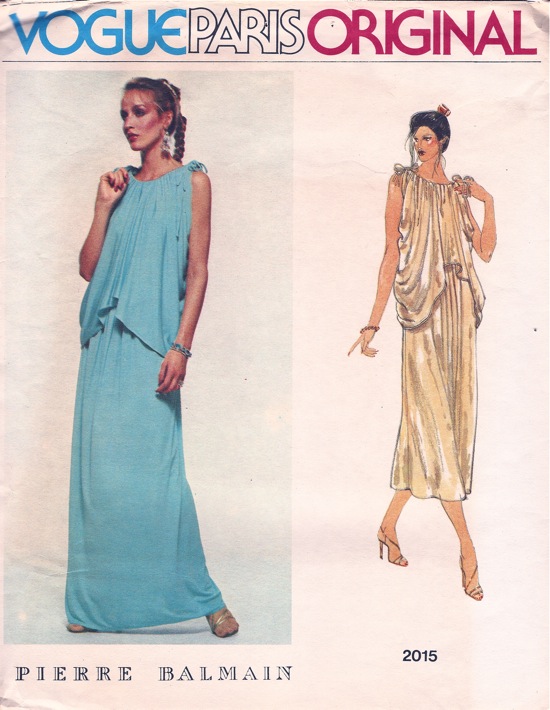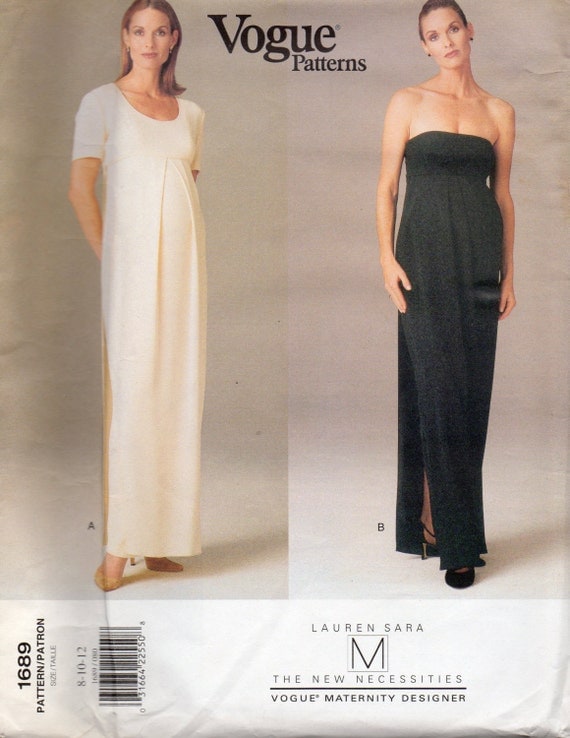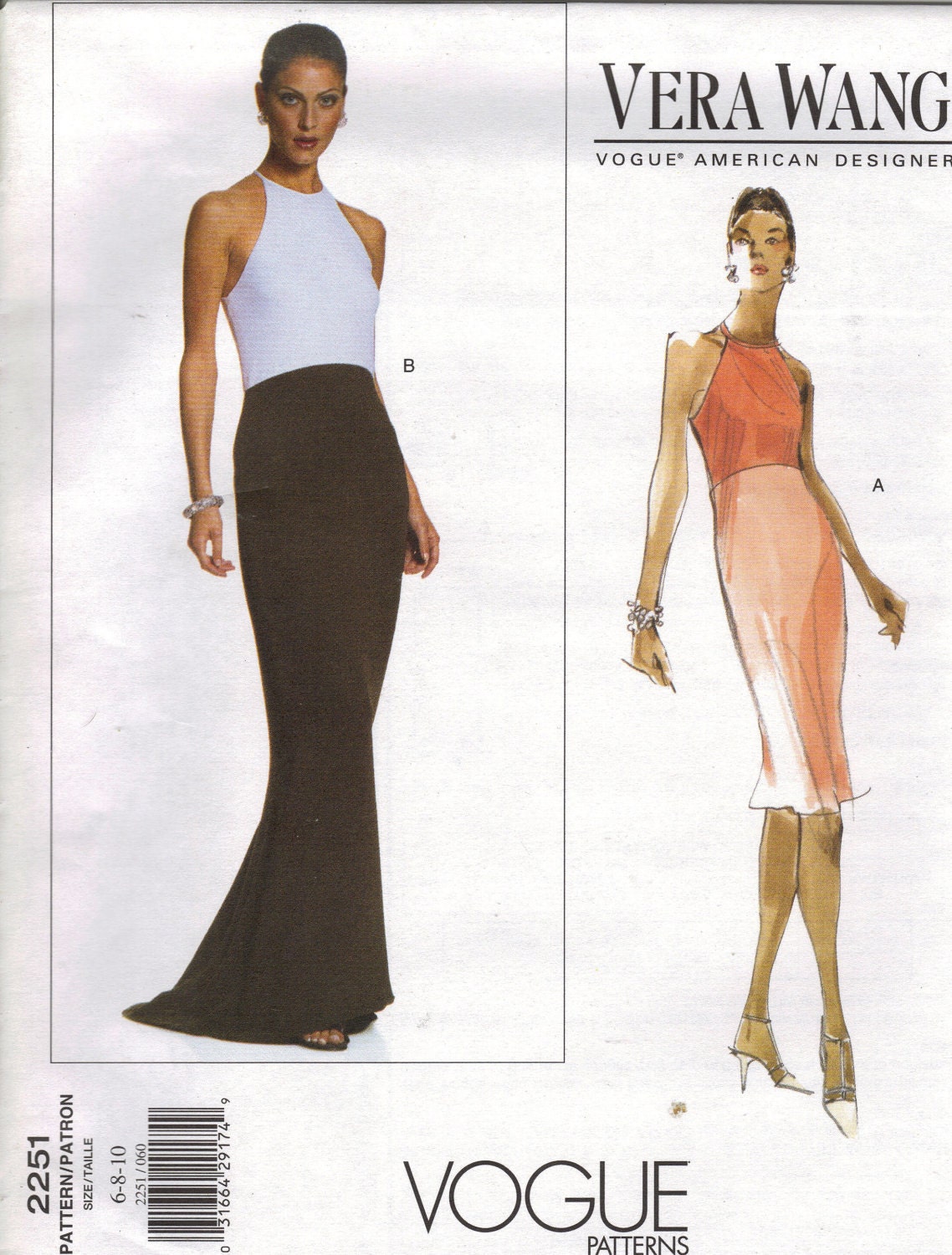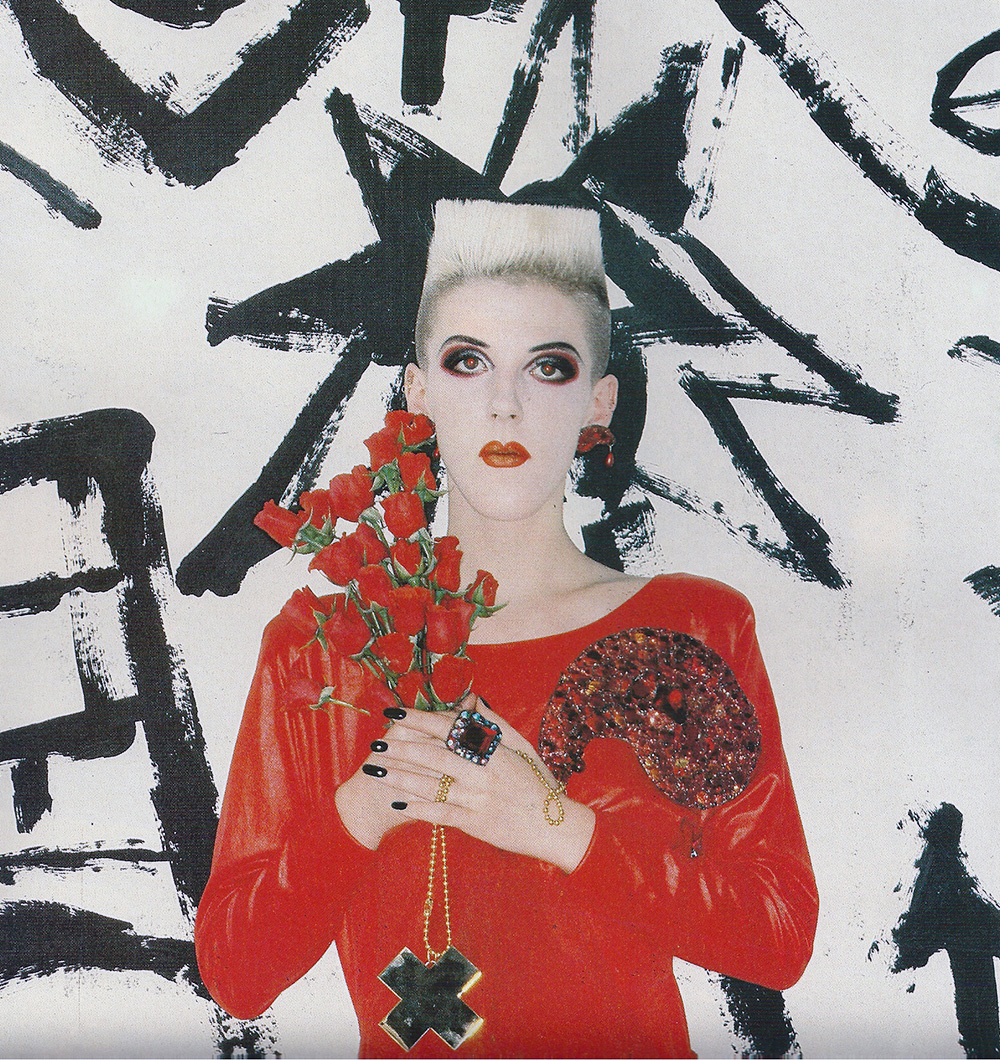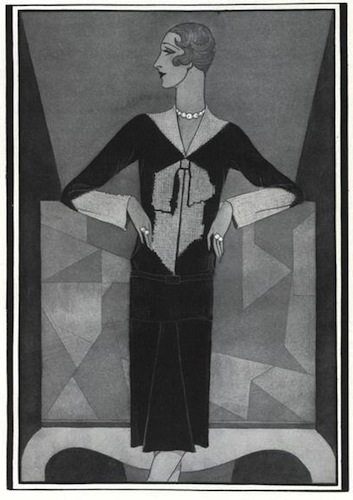![Linda Evangelista in Anna Sui, Harper's Bazaar, August 1995 Linda Evangelista in a mod skirt suit from Anna Sui's FW 1995 collection, photographed by Patrick Demarchelier]()
Linda Evangelista in Anna Sui, Harper’s Bazaar, August 1995. Photo: Patrick Demarchelier.
Anna Sui (b. 1955) is beloved for her playfully postmodern designs. Sui collections are typically full of eclectic, retro references—fun and accessible, but always with an alternative edge. (For a comprehensive discussion of Sui’s work see Andrew Bolton, Anna Sui [Chronicle Books, 2010].)
Anna Sui’s licensing agreement with Vogue Patterns lasted from the mid-1990s until quite recently. There were also Anna Sui knitting patterns, like this paillette-trimmed mohair sweater shown on the cover of Vogue Knitting magazine:
![Anna Sui sweater on the cover of Vogue Knitting, Winter 1998-99 Red, paillette-trimmed Anna Sui sweater on the cover of Vogue Knitting, Winter 1998-99]()
Anna Sui sweater on the cover of Vogue Knitting, Winter 1998-99. Image via Vintageknits.net.
This two-part series will present some highlights from Anna Sui’s earlier Vogue patterns, ordered by collection.
1. Anna Sui, Spring/Summer 1995 collection
Anna Sui was introduced to readers of Vogue Patterns in the July/August 1995 issue with a design from her Spring 1995, vintage ’30s and ’40s collection. Inspirations for this collection included pulp magazines, waitress uniforms, and Minnie Mouse. The collection was notable for its use of textiles, which ranged from nylon pinstripes and rubberized chiffon to prints both rockabilly and haute: some of the dresses and skirts used 1940s prints that were designed by Christian Bérard for Ascher Ltd and specially recoloured for the collection.
Vogue 1619 is a pattern for four dresses with vintage details like cut-in shoulders and puffed or tucked sleeves. The red, bouquet print in the large photo is by Christian Bérard. Vogue later proclaimed the “1940s floral look” the look of the season*:
![Vogue 1619 by Anna Sui (1995) 1990s Anna Sui dress pattern - Vogue 1619]()
Vogue 1619 by Anna Sui (1995) Image via PatternVault on Etsy.
Here’s the Bérard print dress on the runway, complete with red shoes worn with pink socks:
![Anna Sui, SS 1995 Red print dress by Anna Sui, SS 1995 collection]()
Image via New York Daily News.
Vogue 1619 made the cover of Vogue Patterns’ September 1995 catalogue:
![Vogue Patterns catalogue September 1995 Anna Sui's Vogue 1619 on the cover of Vogue Patterns catalogue, September 1995]()
Vogue Patterns catalogue, September 1995. Image via eBay.
Just for fun, here’s a photo of Nicole Kidman in one of the spring collection’s pinstripe suits:
![Nicole Kidman in Anna Sui, Vogue February 1995 Nicole Kidman in Anna Sui pinstripe suit, sequinned cami, with hat and faux stole, photographed by Steven Meisel Vogue February 1995]()
Nicole Kidman in Anna Sui, Vogue, February 1995. Photo: Steven Meisel. Fashion editor: Grace Coddington.
2. Anna Sui, Fall/Winter 1995 collection
For Fall 1995 Sui presented a Mod collection. The show opened with Linda Evangelista on the back of a Lambretta scooter and continued with skinny mod suits and pieces in black leather and sequinned camo, referencing Andy Warhol’s camouflage screenprints.
Vogue 1702’s mod suit includes a front-pleated skirt and sleeveless top—best worn with a matching headscarf (as shown with Vogue 1789):
![Vogue 1702 by Anna Sui (1995) 1990s Anna Sui jacket and pleated skirt pattern - Vogue 1702]()
Vogue 1702 by Anna Sui (1995) Image via Etsy.
Linda Evangelista was photographed in the Vogue 1702 suit by Patrick Demarchelier (see top of post). A tweed version was modelled by Stella Tennant:
![Stella Tennant in Anna Sui, Vogue, October 1995 Stella Tennant in Anna Sui, with rubber boots and fishing rod, photographed by Arthur Elgort, 1995]()
Stella Tennant in Anna Sui, Vogue, October 1995. Photo: Arthur Elgort. Fashion editor: Grace Coddington.
3. Anna Sui, Fall/Winter 1997 collection
Sui’s ‘goth’ collection was presented at the Church of Divine Paternity, a neo-Gothic church on New York’s Upper West Side. Siouxie Sioux was a major inspiration for the show, which had post-punk makeup by François Nars and a wealth of textiles characteristic of old-school goth style, such as velvet, lace, lace-printed chiffon, and fishnet. As Bolton notes, the collection referenced the goth love of historicism in Vivienne Westwood-style bustles and ‘mini-crinis.’
Vogue 2072 is a pattern for two mini-crini dresses trimmed with ribbon and lace. It even includes the mesh top and fingerless gloves (see my earlier post here):
![Vogue 2072 by Anna Sui (1997) 1990s Anna Sui dress, top and gloves pattern - Vogue 2072]()
Vogue 2072 by Anna Sui (1997)
Karen Elson and Tasha Tilberg modelled the Vogue 2072 dresses on the runway, accessorized with matching fingerless gloves, sheer leggings, and beaded devil horns:
![Karen Elson, Tasha Tilberg, Anna Sui FW 1997 Karen Elson and Tasha Tilberg on the runway, Anna Sui FW 1997]()
Models: Karen Elson, Tasha Tilberg. Images: Bolton, Anna Sui and firstVIEW.
The red, view B version of the Vogue 2072 dress, complete with Sui devil horns, was photographed on a young Sofia Coppola:
![Sofia Coppola, Spur, October 1997 Sofia Coppola photographed by Satoshi Saikusa, Spur magazine, October 1997]()
Sofia Coppola, Spur, October 1997. Photo: Satoshi Saikusa. Image: Bolton, Anna Sui.
4. Anna Sui, Spring/Summer 1998 collection
For spring 1998 Sui presented a surfer-inspired collection. Bold prints, bright colours, and bucket hats conveyed the laid-back spirit of surfer subculture, with Hawaiian, Indian, and Balinese prints and accessories evoking days spent on tropical beaches.
Vogue 2152’s three summery little dresses are like a mini vacation wardrobe:
![Vogue 2152 by Anna Sui (1998) 1990s Anna Sui summer dress pattern - Vogue 2152]()
Vogue 2152 by Anna Sui (1998) Image via Etsy.
Here are two of the Vogue 2152 dresses on the runway. The slip dress in view B was worn with a long-sleeved mesh top:
![Kylie Bax and Christina Kruse, Anna Sui SS 1998 Kylie Bax and Christina Kruse on the runway, Anna Sui SS 1998]()
Models: Kylie Bax and Christina Kruse. Images via firstVIEW.
Kate Moss wears another dress from the collection in this editorial photo by Terry Richardson:
![Kate Moss in Anna Sui, Harper's Bazaar, January 1998 Strapless silk sari dress with gold appliqués, Terry Richardson photo of Kate Moss in Anna Sui, Harper's Bazaar, January 1998]()
Kate Moss in Anna Sui, Harper’s Bazaar, January 1998. Photo: Terry Richardson. Image via Bolton, Anna Sui.
The gold-appliquéd pink sari silk was inspired by a dress belonging to the Duchess of Windsor, again bringing home the wide-ranging eclecticism of Sui’s references.
Next: Anna Sui’s Vogue patterns into the 2000s.
* Katherine Betts, “The best & worst looks of the ’90s,” Vogue, January 1996, p. 130.
Tagged:
Anna Sui,
designer,
fashion,
fashion photography,
goth,
ready-to-wear,
sewing,
Vogue Patterns ![]()
![]()
![]()
![]()
![]()
![]()
![]()
![]()









